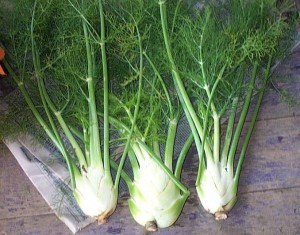Discover Fennel with Moosewood Chef
Posted in Exhibitions, The Edible Garden on September 16 2010, by Plant Talk
 |
Kip Wilcox is a chef at Moosewood Restaurant. She will present cooking demonstrations at The Edible Garden Conservatory Kitchen on Saturday, September 18, at 1 and 3 p.m. and will sign copies of her book, Sweetness and Light, following each demonstration. |
 Fennel is not exactly a household word. Indigenous to the Mediterranean, it is gaining greater visibility on the shelves of supermarkets and in the stalls of farmers markets on this side of the Atlantic. Often labeled with the misnomer sweet anise, a fennel bulb looks a bit like short, broad, greenish-hued, tightly packed stalks of celery with delicate leaves reminiscent of dill. In fact, fennel is a relative of anise and dill as well as cumin, cilantro, and caraway. As an ingredient in cooking, both the fennel bulb and seeds have many of us stumped: How do you slice it or cook the bulb? What does it taste like? What kinds of dishes can include fennel? How do you use the seeds?
Fennel is not exactly a household word. Indigenous to the Mediterranean, it is gaining greater visibility on the shelves of supermarkets and in the stalls of farmers markets on this side of the Atlantic. Often labeled with the misnomer sweet anise, a fennel bulb looks a bit like short, broad, greenish-hued, tightly packed stalks of celery with delicate leaves reminiscent of dill. In fact, fennel is a relative of anise and dill as well as cumin, cilantro, and caraway. As an ingredient in cooking, both the fennel bulb and seeds have many of us stumped: How do you slice it or cook the bulb? What does it taste like? What kinds of dishes can include fennel? How do you use the seeds?
There are two kinds of edible fennel. Common fennel (Foeniculum vulgare) is a hardy perennial herb that grows in the wild and is invasive in Mediterranean climates. It reaches about five feet tall with wispy leaves and beautiful yellow flowers that produce greenish-brown seed-like fruits. Its taproot is long and tenacious, not something you would want to eat. The oil from common fennel’s seeds has been used for centuries as a digestive, diuretic, cough suppressant, soothing eyewash, and breath freshener.
The flavor of common fennel is not unknown in international cookery. You’ve probably already tasted its warm, sweet undertones in Italian sausage, Chinese five-spice powder, and as a subtle undertone in Indian dishes. Fennel also plays a suggestively supportive role for other, more assertive spices in baked goods, fish, chicken, lamb, pork, sauces, and vegetable dishes.
The other, tamer fennel, Florence fennel or finocchio in Italian (F. vulgare var. azoricum) is the kind you find at the grocery store. A tasty and adaptive vegetable, it’s easy to add Florence fennel (pictured) to your culinary repertoire. It’s not surprising that it’s becoming better known, even popular, on this side of the Atlantic as an ingredient in soups, stews, pasta dishes, and salads.
Chop off the tough stalks and remove the hard core, reserving them for soup stock. Slice the bulb to suit your recipe. Brush slices of fennel with a little olive oil and balsamic vinegar, and grill them along with the usual summer eggplant, zucchini, onions, and peppers. Include fennel in bean and vegetable soups, stews, and pasta sauce. Roast slices in the oven for a delicious side dish. Thinly slice or grate the bulb into salads and slaws, or chop it into slender chunks for a delicious, crunchy crudite. Fennel’s faint anise, celery-like flavor and crisp texture pair nicely with creamy dips and dressings, fruits and nuts, cheeses and olives. Its lovely, delicate leaves make a beautiful garnish.
As we enter the height of harvest season, we can find fennel at its freshest and tastiest. It’s easy to spot these shiny, smooth, pale-green, curvaceous bulbs crowned with a dapple of dark-green, feathery fronds snuggling alongside late summer squashes, tomatoes, carrots, cukes, peppers, and greens. To the delight of all of us, Florence fennel is slowly and unassumingly making its way into the heart of our local cuisines.

